| Cyprinidae Temporal range:
| |
|---|---|

| |
| The common carp, Cyprinus carpio | |
| Scientific classification | |
| Domain: | Eukaryota |
| Kingdom: | Animalia |
| Phylum: | Chordata |
| Class: | Actinopterygii |
| Order: | Cypriniformes |
| Superfamily: | Cyprinoidea |
| Family: | Cyprinidae Rafinesque, 1815 |
| Type genus | |
| Cyprinus | |
| Subfamilies | |
and see text | |
Cyprinidae is a family of freshwater fish commonly called the carp or minnow family, including the carps, the true minnows, and their relatives the barbs and barbels, among others. Cyprinidae is the largest and most diverse fish family, and the largest vertebrate animal family overall, with about 3,000 species; only 1,270 of these remain extant, divided into about 200 valid genera.[1][2] Cyprinids range from about 12 mm (0.5 in) in size to the 3 m (9.8 ft) giant barb (Catlocarpio siamensis).[3] By genus and species count, the family makes up more than two-thirds of the ostariophysian order Cypriniformes.[1][2][4] The family name is derived from the Greek word kyprînos (κυπρῖνος 'carp').
Biology and ecology
Cyprinids are stomachless, or agastric, fish with toothless jaws. Even so, food can be effectively chewed by the gill rakers of the specialized last gill bow. These pharyngeal teeth allow the fish to make chewing motions against a chewing plate formed by a bony process of the skull. The pharyngeal teeth are unique to each species and are used to identify species. Strong pharyngeal teeth allow fish such as the common carp and ide to eat hard baits such as snails and bivalves.
Hearing is a well-developed sense in the cyprinids since they have the Weberian organ, three specialized vertebral processes that transfer motion of the gas bladder to the inner ear. The vertebral processes of the Weberian organ also permit a cyprinid to detect changes in motion of the gas bladder due to atmospheric conditions or depth changes. The cyprinids are considered physostomes because the pneumatic duct is retained in adult stages and the fish are able to gulp air to fill the gas bladder, or they can dispose of excess gas to the gut.
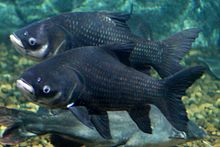
Cyprinids are native to North America, Africa, and Eurasia. The largest known cyprinid is the giant barb (Catlocarpio siamensis), which may grow up to 3 m (9.8 ft) in length and 300 kg (660 lb) in weight.[3] Other very large species that can surpass 2 m (6.6 ft) are the golden mahseer (Tor putitora) and mangar (Luciobarbus esocinus).[5][6] The largest North American species is the Colorado pikeminnow (Ptychocheilus lucius), which can reach up to 1.8 m (5.9 ft) in length.[7] Conversely, many species are smaller than 5 cm (2 in). The smallest known fish is Paedocypris progenetica, reaching 10.3 mm (0.41 in) at the longest.[8]
All fish in this family are egg-layers and most do not guard their eggs; however, a few species build nests and/or guard the eggs. The bitterlings of subfamily Acheilognathinae are notable for depositing their eggs in bivalve molluscs, where the young develop until able to fend for themselves.
Cyprinids contain the first and only known example of androgenesis in a vertebrate, in the Squalius alburnoides allopolyploid complex.[9]
Most cyprinids feed mainly on invertebrates and vegetation, probably due to the lack of teeth and stomach; however, some species, like the asp, are predators that specialize in fish. Many species, such as the ide and the common rudd, prey on small fish when individuals become large enough. Even small species, such as the moderlieschen, are opportunistic predators that will eat larvae of the common frog in artificial circumstances.
Some cyprinids, such as the grass carp, are specialized herbivores; others, such as the common nase, eat algae and biofilms, while others, such as the black carp, specialize in snails, and some, such as the silver carp, are specialized filter feeders. For this reason, cyprinids are often introduced as a management tool to control various factors in the aquatic environment, such as aquatic vegetation and diseases transmitted by snails.
Unlike most fish species, cyprinids generally increase in abundance in eutrophic lakes. Here, they contribute towards positive feedback as they are efficient at eating the zooplankton that would otherwise graze on the algae, reducing its abundance.
Relationship with humans

Food
Cyprinids are highly important food fish; they are fished and farmed across Eurasia. In land-locked countries in particular, cyprinids are often the major species of fish eaten because they make the largest part of biomass in most water types except for fast-flowing rivers. In Eastern Europe, they are often prepared with traditional methods such as drying and salting. The prevalence of inexpensive frozen fish products made this less important now than it was in earlier times. Nonetheless, in certain places, they remain popular for food, as well as recreational fishing, for ornamental use, and have been deliberately stocked in ponds and lakes for centuries for this reason.[11]
Sport
Cyprinids are popular for angling especially for match fishing (due to their dominance in biomass and numbers) and fishing for common carp because of its size and strength.
As pest control
Several cyprinids have been introduced to waters outside their natural ranges to provide food, sport, or biological control for some pest species. The common carp (Cyprinus carpio) and the grass carp (Ctenopharyngodon idella) are the most important of these, for example in Florida.
As a pest species
Carp in particular can stir up sediment, reducing the clarity of the water and making plant growth difficult.[12][13]
In America and Australia, such as the Asian carp in the Mississippi Basin, they have become invasive species that compete with native fishes or disrupt the environment.
Cyprinus carpio is a major pest species in Australia impacting freshwater environments, amenity, and the agricultural economy, devastating biodiversity by decimating native fish populations where they first became established as a major pest in the wild in the 1960s. In the major river system of eastern Australia, the Murray-Darling Basin, they constitute 80–90 per cent of fish biomass.[14]
In 2016 the federal government announced A$15.2 million to fund the National Carp Control Plan to investigate using Cyprinid herpesvirus 3 (carp virus) as a biological control agent while minimising impacts on industry and environment should a carp virus release go ahead. Despite initial, favourable assessment,[15][16][17] in 2020 this plan was found to be unlikely to work due to the high fecundity of the fish.[18]
Aquarium fish
Numerous cyprinids have become popular and important within the aquarium and fishpond hobbies, most famously the goldfish, which was bred in China from the Prussian carp (Carassius (auratus) gibelio). First imported into Europe around 1728, it was originally much-fancied by the Chinese nobility as early as 1150 AD and, after it arrived there in 1502, also in Japan. In addition to the goldfish, the common carp was bred in Japan into the colorful ornamental variety known as koi — or more accurately nishikigoi (錦鯉), as koi (鯉) simply means "common carp" in Japanese — from the 18th century until today.
Other popular aquarium cyprinids include danionins, rasborines and true barbs.[19] Larger species are bred by the thousands in outdoor ponds, particularly in Southeast Asia, and trade in these aquarium fishes is of considerable commercial importance. The small rasborines and danionines are perhaps only rivalled by characids (tetras) and poecilid livebearers in their popularity for community aquaria.[citation needed] Some of the most popular cyprinids among aquarists, other than goldfish and koi, include the cherry barb, Harlequin rasbora, pearl danios, rainbow sharks, tiger barbs, and the White Cloud Mountain minnow.
One particular species of these small and undemanding danionines is the zebrafish (Danio rerio). It has become the standard model species for studying developmental genetics of vertebrates, in particular fish.[20]
Threatened families
Habitat destruction and other causes have reduced the wild stocks of several cyprinids to dangerously low levels; some are already entirely extinct. In particular, the cyprinids of the subfamily Leuciscinae from southwestern North America have been hit hard by pollution and unsustainable water use in the early to mid-20th century; most globally extinct cypriniform species are in fact leuciscinid cyprinids from the southwestern United States and northern Mexico.
Systematics
The massive diversity of cyprinids has so far made it difficult to resolve their phylogeny in sufficient detail to make assignment to subfamilies more than tentative in many cases. Some distinct lineages obviously exist – for example, the Cultrinae and Leuciscinae, regardless of their exact delimitation, are rather close relatives and stand apart from Cyprininae – but the overall systematics and taxonomy of the Cyprinidae remain a subject of considerable debate. A large number of genera are incertae sedis, too equivocal in their traits and/or too little-studied to permit assignment to a particular subfamily with any certainty.[21][22][23]
Part of the solution seems that the delicate rasborines are the core group, consisting of minor lineages that have not shifted far from their evolutionary niche, or have coevolved for millions of years. These are among the most basal lineages of living cyprinids. Other "rasborines" are apparently distributed across the diverse lineages of the family.[22]
The validity and circumscription of proposed subfamilies like the Labeoninae or Squaliobarbinae also remain doubtful, although the latter do appear to correspond to a distinct lineage. The sometimes-seen grouping of the large-headed carps (Hypophthalmichthyinae) with Xenocypris, though, seems quite in error. More likely, the latter are part of the Cultrinae.[22]
The entirely paraphyletic "Barbinae" and the disputed Labeoninae might be better treated as part of the Cyprininae, forming a close-knit group whose internal relationships are still little known. The small African "barbs" do not belong in Barbus sensu stricto – indeed, they are as distant from the typical barbels and the typical carps (Cyprinus) as these are from Garra (which is placed in the Labeoninae by most who accept the latter as distinct) and thus might form another as yet unnamed subfamily. However, as noted above, how various minor lineages tie into this has not yet been resolved; therefore, such a radical move, though reasonable, is probably premature.[21][24]
The tench (Tinca tinca), a significant food species farmed in western Eurasia in large numbers, is unusual. It is most often grouped with the Leuciscinae, but even when these were rather loosely circumscribed, it always stood apart. A cladistic analysis of DNA sequence data of the S7 ribosomal protein intron 1 supports the view that it is distinct enough to constitute a monotypic subfamily. It also suggests it may be closer to the small East Asian Aphyocypris, Hemigrammocypris, and Yaoshanicus. They would have diverged roughly at the same time from cyprinids of east-central Asia, perhaps as a result of the Alpide orogeny that vastly changed the topography of that region in the late Paleogene, when their divergence presumably occurred.[23]
A DNA-based analysis of these fish places the Rasborinae as the basal lineage with the Cyprininae as a sister clade to the Leuciscinae.[25] The subfamilies Acheilognathinae, Gobioninae, and Leuciscinae are monophyletic.
Subfamilies and genera




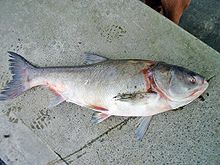
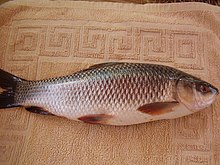

The 5th Edition of Fishes of the World sets out the following subfamilies:[26]

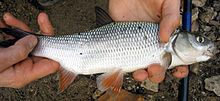

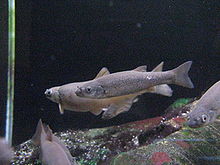
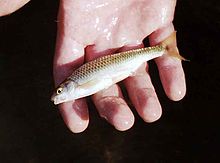
Subfamily Leuciscinae
|
|


Subfamily Squaliobarbinae
Subfamily Tincinae
|
Subfamily Xenocyprinae
|

Possibly related to Aphyocypris.
With such a large and diverse family the taxonomy and phylogenies are always being worked on so alternative classifications are being created as new information is discovered, for example:[37]
Phylogeny
| Phylogeny of living Cyprinoidei[37][38] with clade names from van der Laan 2017.[39] |
Subfamily Probarbinae
Subfamily Labeoninae
- Tribe Parapsilorhynchini
- Tribe Labeonini
- Bangana
- Cirrhinus (mud carps)
- Decorus[40]
- Gymnostomus
- Incisilabeo
- Labeo (labeos)
- Speolabeo
- Schismatorhynchos
- Tribe Garrini
- Garra
- Paracrossocheilus
- Tariqilabeo
- Osteochilus clade
- Semilabeo clade
Subfamily Torinae
- Tribe Torini[42]
- Arabibarbus [43]
- Carasobarbus
- Labeobarbus (yellowfish)
- Mesopotamichthys
- Pterocapoeta
|
|
Subfamily Smiliogastrinae
- Tribe Smiliogastrini[44]
- Amatolacypris
- Cheilobarbus
- Enteromius (African barbs)
- Namaquacypris
- Pseudobarbus (redfins)
- Sedercypris (Cedarberg redfins)
|
Subfamily Cyprininae [incl. Barbinae]
|
|
Subfamily Danioninae
|
|
Subfamily Leptobarbinae







Subfamily Xenocypridinae [incl. Cultrinae & Squaliobarbinae]
|
|
Subfamily Tincinae
Subfamily Acheilognathinae (bitterlings)
- ?Acanthorhodeus (Khanka spiny bitterling)
- Acheilognathus
- Paratanakia
- Pseudorhodeus
- Rhodeus
- Tanakia
Subfamily Gobioninae
|
|
Subfamily Tanichthyinae
Subfamily Leuciscinae [incl. Alburninae]
|
|

Possibly related to Aphyocypris.
|
|
See also
References
- ^ a b Froese, Rainer; Pauly, Daniel (eds.). "Family Cyprinidae". FishBase. July 2015 version.
- ^ a b Eschmeyer, William N.; Fricke, Ron & van der Laan, Richard (eds.). "Genera in the family Cyprinidae". Catalog of Fishes. California Academy of Sciences. Retrieved 2 July 2015.
- ^ a b Froese, Rainer; Pauly, Daniel (eds.). "Catlocarpio siamensis". FishBase. March 2015 version.
- ^ Nelson, Joseph (2006). Fishes of the World. Chichester: John Wiley & Sons. ISBN 0-471-25031-7.
- ^ Froese, Rainer; Pauly, Daniel (eds.). "Tor putitora". FishBase. March 2017 version.
- ^ Froese, Rainer; Pauly, Daniel (eds.). "Luciobarbus esocinus". FishBase. March 2017 version.
- ^ Froese, Rainer; Pauly, Daniel (eds.). "Ptychocheilus lucius". FishBase. March 2015 version.
- ^ Froese, Rainer; Pauly, Daniel (eds.). "Paedocypris progenetica". FishBase. March 2015 version.
- ^ Morgado-Santos, Miguel; Carona, Sara; Vicente, Luís; Collares-Pereira, Maria João (2017). "First empirical evidence of naturally occurring androgenesis in vertebrates". Royal Society Open Science. 4 (5): 170200. Bibcode:2017RSOS....470200M. doi:10.1098/rsos.170200. PMC 5451830. PMID 28573029.
- ^ Based on data sourced from the FishStat database
- ^ MacMahon, Alexander Francis Magri (1946). Fishlore: British Freshwater Fishes. Pelican Books. Vol. 161. Penguin Books. pp. 149–152.
- ^ Gulf States Marine Fisheries Commission (3 August 2005). "Cyprinus carpio (Linnaeus, 1758)". Archived from the original on 18 August 2007. Retrieved 3 May 2007.
- ^ Florida Fish and Wildlife Conservation Commission (2006). "Exotic Freshwater Fishes". Archived from the original on 8 February 2007. Retrieved 5 March 2007.
- ^ Peterson, Douglas; Pearson, James; Simpson, William (2022-05-30). "Effects of common carp on water quality and submerged vegetation: results from a short-term mesocosm experiment in an artificial wetland". Marine and Freshwater Research. 73 (7): 973–994. doi:10.1071/mf22008. ISSN 1323-1650. S2CID 249222934.
- ^ Mankad, Aditi; Zhang, Airong; Carter, Lucy; Curnock, Matthew (March 2022). "A path analysis of carp biocontrol: effect of attitudes, norms, and emotion on acceptance". Biological Invasions. 24 (3): 709–723. Bibcode:2022BiInv..24..709M. doi:10.1007/s10530-021-02679-1. ISSN 1387-3547. S2CID 244518717.
- ^ Kilvert, Nick; Thomas, Kerrin (1 May 2016). "Herpes virus to be used in fight against carp in Murray River, Christopher Pyne says". ABC News. Australian Broadcasting Corporation. Archived from the original on 5 May 2016.
- ^ "Carp herpesvirus". Managing Water Ecosystems - CSIRO. 2018-04-26. Retrieved 2020-11-09.
- ^ Mintram, Kate S.; Oosterhout, Cock; Lighten, Jackie (2020-10-14). Knutie, Sarah (ed.). "Genetic variation in resistance and high fecundity impede viral biocontrol of invasive fish". Journal of Applied Ecology. 58. Wiley: 148–157. doi:10.1111/1365-2664.13762. ISSN 0021-8901.
- ^ Riehl, R.; Baensch, H. (1996). Aquarium Atlas Volume 1. Voyageur Press. p. 410.
- ^ Helfman, Gene S.; Collette, Bruce B.; Facey, Douglas E. (1997). The diversity of fishes. Malden, Mass: Blackwell Science. p. 228. ISBN 978-0-86542-256-8. OCLC 299475257.
- ^ a b De Graaf, Martin; Megens, Hendrik-Jan; Samallo, Johannis; Sibbing, Ferdinand A. (2007). "Evolutionary origin of Lake Tana's (Ethiopia) small Barbus species: Indications of rapid ecological divergence and speciation". Animal Biology. 57: 39–48. doi:10.1163/157075607780002069.
- ^ a b c He, Shunping; Mayden, Richard L.; Wang, Xuzheng; Wang, Wei; Tang, Kevin L.; Chen, Wei-Jen; Chen, Yiyu (2008). "Molecular phylogenetics of the family Cyprinidae (Actinopterygii: Cypriniformes) as evidenced by sequence variation in the first intron of S7 ribosomal protein-coding gene: Further evidence from a nuclear gene of the systematic chaos in the family" (PDF). Molecular Phylogenetics and Evolution. 46 (3): 818–29. Bibcode:2008MolPE..46..818H. doi:10.1016/j.ympev.2007.06.001. PMID 18203625. Archived (PDF) from the original on 2011-08-11.
- ^ a b He, Shunping; Gu, Xun; Mayden, Richard L.; Chen, Wei-Jen; Conway, Kevin W.; Chen, Yiyu (2008). "Phylogenetic position of the enigmatic genus Psilorhynchus (Ostariophysi: Cypriniformes): Evidence from the mitochondrial genome" (PDF). Molecular Phylogenetics and Evolution. 47 (1): 419–25. Bibcode:2008MolPE..47..419H. doi:10.1016/j.ympev.2007.10.012. PMID 18053751. Archived (PDF) from the original on 2020-07-29.
- ^ Howes, G.I. (1991). "Systematics and biogeography: an overview". In Winfield, I.J.; Nelson, J.S. (eds.). Biology of Cyprinids. London: Chapman and Hall Ltd. pp. 1–33.
- ^ Tao, Wenjing; Mayden, Richard L.; He, Shunping (March 2013). "Remarkable phylogenetic resolution of the most complex clade of Cyprinidae (Teleostei: Cypriniformes): A proof of concept of homology assessment and partitioning sequence data integrated with mixed model Bayesian analyses". Molecular Phylogenetics and Evolution. 66 (3): 603–616. Bibcode:2013MolPE..66..603T. doi:10.1016/j.ympev.2012.09.024. ISSN 1055-7903. PMID 23044401. Archived from the original on 2020-06-08. Retrieved 2019-12-07.
- ^ J. S. Nelson; T. C. Grande; M. V. H. Wilson (2016). Fishes of the World (5th ed.). Wiley. pp. 181–186. ISBN 978-1-118-34233-6. Archived from the original on 2019-04-08. Retrieved 2019-09-05.
- ^ a b c d Pethiyagoda, R.; Meegaskumbura, M.; Maduwage, K. (2012). "A synopsis of the South Asian fishes referred to Puntius (Pisces: Cyprinidae)". Ichthyological Exploration of Freshwaters. 23 (1): 69–95. ISSN 0936-9902.
- ^ a b c d e f g h Kottelat, M. (2013). "The Fishes of the Inland Waters of Southeast Asia: A Catalogue and Core Bibliography of the Fishes Known to Occur in Freshwaters, Mangroves and Estuaries" (PDF). The Raffles Bulletin of Zoology (Supplement No. 27): 1–663. Archived from the original (PDF) on 2 December 2013.
- ^ Pethiyagoda, R (2013). "Haludaria, a replacement generic name for Dravidia (Teleostei: Cyprinidae)" (PDF). Zootaxa. 3646 (2): 199. doi:10.11646/zootaxa.3646.2.9. PMID 26213759.
- ^ a b Chang, Meemann; et al. (2008). "Extraordinarily thick-boned fish linked to the aridification of the Qaidam Basin (northern Tibetan Plateau)". Proceedings of the National Academy of Sciences. 105 (36): 13246–13251. Bibcode:2008PNAS..10513246C. doi:10.1073/pnas.0805982105. PMC 2533176. PMID 18757732.
- ^ a b Britz, Ralf; Kottelat, Maurice; Tan, Heok (1 December 2011). "Fangfangia spinicleithralis, a new genus and species of miniature cyprinid fish from the peat swamp forests of Borneo (Teleostei: Cyprinidae)". Ichthyological Exploration of Freshwaters. 22 (4): 327–335.
- ^ a b Zhao, H.-T.; Sullivan, J.P.; Zhang, Y.-G.; Peng, Z.-G. (2014). "Paraqianlabeo lineatus, a new genus and species of labeonine fishes (Teleostei: Cyprinidae) from South China". Zootaxa. 3841 (2): 257–270. doi:10.11646/zootaxa.3841.2.5. PMID 25082039.
- ^ Zhang, E; Zhou, W (2012). "Sinigarra napoense, a new genus and species of labeonin fishes (Teleostei: Cyprinidae) from Guangxi Province, South China" (PDF). Zootaxa. 3586: 17–25. doi:10.11646/zootaxa.3586.1.4. S2CID 2027617.
- ^ a b Huang, Y.; Yang, J.; Chen, X. (2014). "Stenorynchoacrum xijiangensis, a new genus and a new species of Labeoninae fish from Guangxi, China (Teleostei: Cyprinidae)". Zootaxa. 3793 (3): 379–386. doi:10.11646/zootaxa.3793.3.6. PMID 24870177.
- ^ Nguyen, V.H.; Nguyen, H.D.; Nguyen, T.D.P. (2016). "Vinalabeo, a new generic name for Vinalabeo tonkinensis (Cyprinidae, Teleostei)". Journal of Science of Hnue, Natural Sciences. 61 (9): 140–144. doi:10.18173/2354-1059.2016-0066.
- ^ a b c d Bianco, P.G.; Ketmaier, V. (2014). "A revision of the Rutilus complex from Mediterranean Europe with description of a new genus, Sarmarutilus, and a new species, Rutilus stoumboudae (Teleostei: Cyprinidae)" (PDF). Zootaxa. 3841 (3): 379–402. doi:10.11646/zootaxa.3841.3.4. hdl:11573/589382. PMID 25082046.
- ^ a b Betancur-Rodriguez, Ricardo; Edward O. Wiley; Gloria Arratia; Arturo Acero; Nicolas Bailly; Masaki Miya; Guillaume Lecointre; Guillermo Ortí (2017). "Phylogenetic classification of bony fishes". BMC Evolutionary Biology. 17 (162) (4 ed.): 162. Bibcode:2017BMCEE..17..162B. doi:10.1186/s12862-017-0958-3. PMC 5501477. PMID 28683774.
- ^ Lei Yang; Tetsuya Sado; M. Vincent Hirt; Emmanuel Pasco-Viel; M. Arunachalam; Junbing Li; Xuzhen Wang; Jörg Freyhof; Kenji Saitoh; Andrew M. Simons; Masaki Miya; Shunping He; Richard L. Mayden (2015). "Phylogeny and Polyploidy: Resolving the Classification of Cyprinine Fishes (Teleostei: Cypriniformes)". Molecular Phylogenetics and Evolution. 85 (February 2015): 97–116. Bibcode:2015MolPE..85...97Y. doi:10.1016/j.ympev.2015.01.014. PMID 25698355. Archived from the original on 2021-03-06. Retrieved 2019-12-07.
- ^ van der Laan, Richard (December 2017). Freshwater fish list (PDF) (23rd ed.). p. 997. ISSN 2468-9157.
- ^ Zheng, Lan-Ping; Chen, Xiao-Yong; Yang, Jun-Xing (2019). "Molecular phylogeny and systematic revision of Bangana sensu lato (Teleostei, Cyprinidae)". Journal of Zoological Systematics and Evolutionary Research. 57 (4): 884–891. doi:10.1111/jzs.12294. S2CID 190878336.
- ^ Zhang, E; Zhou, W (2012). "Sinigarra napoense, a new genus and species of labeonin fishes (Teleostei: Cyprinidae) from Guangxi Province, South China" (PDF). Zootaxa. 3586: 17–25. doi:10.11646/zootaxa.3586.1.4. S2CID 2027617.
- ^ Kai Borkenhagen (22 February 2017). "Molecular phylogeny of the tribe Torini Karaman, 1971 (Actinopterygii: Cypriniformes) from the Middle East and North Africa". Zootaxa. 4236 (2): zootaxa.4236.2.4. doi:10.11646/zootaxa.4236.2.4. PMID 28264326.
- ^ Borkenhagen, K (2014). "A new genus and species of cyprinid fish (Actinopterygii, Cyprinidae) from the Arabian Peninsula, and its phylogenetic and zoogeographic affinities". Environmental Biology of Fishes. 97 (10): 1179–1195. Bibcode:2014EnvBF..97.1179B. doi:10.1007/s10641-014-0315-y. S2CID 14947417.
- ^ Ndeda, Violet M.; Mariana Mateos & Luis A. Hurtado (26 October 2018). "Evolution of African barbs from the Lake Victoria drainage system, Kenya". PeerJ. 6: e5762. doi:10.7717/peerj.5762. PMC 6204829. PMID 30386696.
- ^ Pethiyagoda, R (2013). "Haludaria, a replacement generic name for Dravidia (Teleostei: Cyprinidae)" (PDF). Zootaxa. 3646 (2): 199. doi:10.11646/zootaxa.3646.2.9. PMID 26213759.
- ^ Yang J, He S, Freyhof J, Witte K, Liu H (2006). "The phylogenetic relationships of the Gobioninae (Teleostei: Cyprinidae) inferred from mitochondrial cytochrome b gene sequences". Hydrobiologia. 553: 255–66. doi:10.1007/s10750-005-1301-3. S2CID 28572859.
External links
![]() Media related to Cyprinidae at Wikimedia Commons
Media related to Cyprinidae at Wikimedia Commons
![]() Data related to Cyprinidae at Wikispecies
Data related to Cyprinidae at Wikispecies









